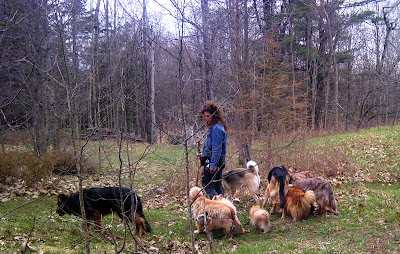How to Crate Train Your Puppy, Dog - Tips for Success
Introduce and familiarize your
puppy or dog to a crate the right way your dog will not fear or take a
disliking to the crate. The crate will not be associated with anxiety and
stress…
Introducing, Familiarizing Your Dog with Her Crate
Encourage
Your Dog to Explore the Crate On His/Her Own
When first
introducing your puppy or dog to a crate, leave the crate door open and
allow your dog to explore the outside and inside of the crate.
Provided you are grounded in your own emotions - i.e. you ‘feel’ that the crate
is just another item of furniture in the house, your dog will have no reason to
have an adverse reaction to the crate - your dog will be supported in
normalizing the existence, presence and use of the crate.
Your dog should
use his/her nose to sniff the crate, explore both the inside and outside of the
crate at his/her leisure. You can put a favorite blanket or toy in the crate to
further encourage your dog’s curiosity and normalization of the crate. Don’t
make a big excited fuss over the crate - high pitched voices, excited energy
etc. Remember that you want your dog to associate the crate with ‘normal’,
calm, grounded - relaxed. Don’t wind your dog up, instead quietly - from a
place of inner warmth just enjoy watching your dog explore.
Closing The
Door For The First Time
If you feel
uncertain, nervous, guilty, anticipate reactive behaviour etc. your dog can
sense how you feel and your dog will not be comfortable with the closing of the
crate door. Why should he/she be comfortable if you are not? If you want your
dog to be in a certain state-of-being you must be in that state first. Dogs
love pure logic because they are insightful
communicators. Once your dog has entered the crate you can close the door -
provided you think of closing the door as normal. It is up to you to lead - you
can create normal or you can create stress.
If you
anticipate that your dog will panic, will be uncomfortable, and will not like
the crate - you are directing your dog to panic, be uncomfortable and not trust
the crate. Dogs are literal beings - not because they are simple-minded nor
stupid but instead because they are very aware communicators.
Once a dog has
found a crate to be a normal, comfortable place, leave the crate door open when
the crate is not in active use - this way the dog may choose to use the crate
as a place of rest even when you have not directed him/her to go to the
crate.
Letting Your Dog Out of Her Crate
To Let Your
Dog Out of The Crate
The same
principles that apply to closing the crate door apply to opening the door -
normalize. When you go to let your dog back out of the crate, make sure you are
grounded (calm, normal) and that you are not in a hurry. If your dog is excited
- just breathe
to direct your dog to calm. Don’t speak, don’t obsess about your dog’s state,
don’t argue
or plead - just breathe and clear your thoughts. Don’t open the door until
your dog is calm. Dogs understand how to pressure and dogs are persist - if you
want calm you have to work for it - direct
from a place of pure logic.
When your dog is
calm, place your hand on the crate door handle - but don’t open the door yet.
If your dog’s excited state is initiate or further heightened when you
reach for a touch the door handle, take your hand off of the door handle. Once
again help your dog calm. When your dog is calm your hand can go back to the
handle.
Open the door a
little - if your dog escalates to excitement gently close the door and start
again. When your dog calms open the door slightly - don’t ‘guard’ the opening.
If you feel the ‘need’ to guard you are inviting your dog to compete with you
for the opening. Don’t create a competition.
Just because you
open the door does not mean that your dog should push his/her way out through
the door. Indicate to your dog to sit. Do not allow him/her to ‘bolt’ out of
the crate.
Stand in the
space created by the open crate door - occupy the space with a comfortable
grounded stance - one leg slightly in front of the other. When your dog is
calm, release the space by moving to one side of the open door and then use
your hand to draw his eyes up to you and then use a hand gesture to indicate
that he/she can now step out of the crate. Then cue him/her to calm once more
by taking a deep breath as he/she exists the crate.
 |
| Time to clean my face and wake up! |
Don’t Wind Your Dog Up
When you come
home don’t create an environment of high energy, intense excitement - just be
normal. Do you want your dog to jump all over you, whine and bark, be anxious
when you leave and arrive? Learn how to great your dog with selfless love by greeting
in silence.
Dogs
With High-Level Anxiety
Determination, presence of mind and patience is required to affect change. Work on your own self-control, and self awareness first. Follow the steps above and do not allow emotion - yours or your dog’s to rule. Staying grounded takes practice - it is not reasonable to expect your dog to be grounded and calm when you are not.
Determination, presence of mind and patience is required to affect change. Work on your own self-control, and self awareness first. Follow the steps above and do not allow emotion - yours or your dog’s to rule. Staying grounded takes practice - it is not reasonable to expect your dog to be grounded and calm when you are not.
Don’t Allow Your Dog to ‘Own’ Her Crate
It is important
to teach your dog that that he/she does not own his/her crate. The crate is a
‘common’ space - a space that is not singularly owned - it is a shared space.
I have worked
with dogs that were allowed to ‘own’ and guard his/her crate to the point of
extreme aggressive-reactivity - should anyone (human, dog, cat) approach the
crate. It takes skill and knowledge to reverse this behaviour and while I can
do so, it is better to avoid creating the situation in the first place.Save
yourself and your dog the distress...
Don’t use a
crate as a place of ‘punishment, don’t use the crate in anger. Doing so creates
many issues including aggressive reactivity.
Crates Are Not For Punishment
A crate should
NEVER be used as a means to ‘punish’ a dog. In-fact when working with your dog
you should never seek to punish. Dogs do not require punishment. Punishment
simply serves to destabilize a dog. Punishment creates insecurity, fear, the
need to react defensively, to shut down - psychological damage which can also
result in physical damage. A dog requires fair, logical, respectful mentoring.
Make Sure the Crate is the Right Size for your Dog
Your dog should
be able to comfortably stand up and turn around in his /her crate.
Location Matters
Never place a
crate in a location that:
- Gets overly warm
- Where there is a cold draft
- Where the air quality is poor
- Where lighting is harsh
Should You Cover the Crate?
Covering the
crate can lead to expectations that are not met and the end result can be
increased anxiety for you and your dog. Some people, trainers and behaviorists
included believe that by covering the crate they will moderate or even solve a
dog’s crate-anxiety. Covering the crate may simply serve to reduce air
circulation and therefore reduce air quality. When I work with a client whose
dog is suffering from crate-anxiety and the crate is covered, one of the first
things I do is remove the cover. Then I teach the client how to resolve the root
cause of the anxiety.
A Comfortable Place
My dogs lie in their crates when they feel like it. They are allowed to
lie down wherever they like in my house – including on couches. Sometimes they
prefer a crate. No one dog in my pack owns a crate – they all share the spaces
in the house including crates. Why do they choose the crate? The crate is a
space of comfort and calm and all of the crates in my house are comfy – they
are lined with dog beds and some have pillows too.
Even dogs who
are capable of escaping any crate – like my dog Sarah (German Shepherd X Husky) will accept being in a crate when
coached and mentored the right way. Sarah is a wily, intelligent and
resourceful canine who spent the better part of her first year as a stray –
wiliness meant survival. Sarah can open any type of crate door handle/lock and
escape at will - however if I put her in a crate she will stay in it. My
control over Sarah is not based on physical force - no amount of physical
restraint can stop a determined dog from attempting to and escaping from a
crate, room etc. My control over Sarah and my client’s dogs is based on
self-restraint, self-awareness, self-discipline, respectful and logical
communication - true leadership.
I work with dogs
that have extreme separation anxiety - including cases where a dog has suffered
severe injury while chewing through and escaping from for his/her crate.
Hate The Crate?
Many people
think that their dog’s reason for extreme behaviour is that he/she ‘hates’
his/her crate.
Not so.
In the majority
of cases it is the human that:
- Accidentally enables an existing condition of insecurity (i.e. in the case of an adopted dog), or;
- Creates the insecurity in the first place. Returning the situation back to normal requires that all aspects of the situation be addressed - human and canine.
Is Crating Your Dog Cruel?
A crate can
be a place of great cruelty...
- A dog should not live his/her life in a crate
- A crate, as noted further above should not be used to punish a dog, dogs should not be punished - dogs need coaching and mentoring - not punishment.
A crate can
be a place of comfort, support...
- A crate can be an amazing tool to help a dog learn to transition from a state of insecurity to a state of normal, grounded, confidence.
- A crate can be a place to help the healing process - after physical trauma or surgery
A place of positive support
or negativity - it all depends on the human.
Holistic Diet, Nutrition, Wellness Services Tailored to Your Individual Dog and Cat
For information about my holistic diet, nutrition, wellness services visit my:
Maintain good health | Address acute and chronic health issues | Pre and post surgery support and recovery
My holistic wellness services are available worldwide via video consultation.
🌎 USA | Canada | UK | Europe | Australia | New Zealand | Asia | South and Central America | Africa | UAE
📱 FaceTime | Facebook | Skype | WhatsApp
Holistic Behavioral Services For Your Dog
For information about my holistic behavioral services visit my:
For dogs of all ages, sizes and breeds
My holistic behavioral services are available locally in-person and worldwide via video session.
🌎 USA | Canada | UK | Europe | Australia | New Zealand | Asia | South and Central America | Africa | UAE
📱 FaceTime | Facebook | Skype | WhatsApp
Affiliations to Companies
✓ None.
✓ I don't sell food or supplements.
✓ I'm not aligned with any companies.
✓ None.
✓ I don't sell food or supplements.
✓ I'm not aligned with any companies.
Article and graphics by Karen Rosenfeld











